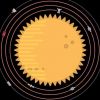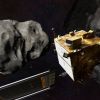-
 +12 +1
+12 +1NASA says it successfully changed asteroid’s path in test of planetary defense
A NASA spacecraft successfully changed an asteroid’s orbit by intentionally smashing into it last month, agency officials confirmed Tuesday. NASA said data obtained over the past two weeks showed that the DART probe’s impact with a small, harmless space rock known as Dimorphos did manage to alter its trajectory.
-
 +3 +1
+3 +1NASA spacecraft have smashed into an asteroid as part of a mission to protect Earth! -
A NASA spacecraft has smashed into an asteroid as part of a mission to protect Earth. The asteroid called by the name “Dimorphos” was smashed by an unnamed rocket launched by NASA. The asteroid, Dimorphos was smashed just as an example of how the Planet Earth can be saved when real big asteroids come towards the earth. Dimorphos was 560ft wide. Dimorphos was no real threat to the earth but was a part of an experiment.
-
 +23 +1
+23 +1Water in asteroid dust offers clues to life on Earth
Specks of dust retrieved by a Japanese space probe from an asteroid some 300 million kilometres from Earth have revealed a surprising component: a drop of water, scientists said Friday. The discovery offers new support for the theory that life on Earth was seeded from outer space.
-
 +18 +1
+18 +1NASA gears up to deflect an asteroid
The U.S. space agency will launch a spacecraft next month on a mission to slam into an asteroid in October, and scientists are hopeful the impact will create a small crater that could help them learn how to better defend against future threats.
-
 +14 +1
+14 +1NASA's DART asteroid-impact mission will be a key test of planetary defense
When NASA's Double Asteroid Redirection Test (DART) slams into the tiny asteroid Dimorphos, it will be our first attempt to demonstrate our ability to deflect dangerous incoming asteroids.
-
 +18 +1
+18 +1Space mission shows Earth's water may be from asteroids: study
Water may have been brought to Earth by asteroids from the outer edges of the solar system, scientists said after analysing rare samples collected on a six-year Japanese space mission. In a quest to shed light on the origins of life and the formation of the universe, researchers are scrutinising material brought back to earth in 2020 from the asteroid Ryugu.
-
 +19 +1
+19 +1Astronomers say never-before-seen asteroids are hiding in the Sun's glare
Astronomers say that a bunch of asteroids could hide in the Sun’s glare. These near-Earth asteroids would most likely be objects we’ve never detected, as most telescope systems look outward from our Solar System. Recent surveys have revealed never-before-seen asteroids hiding near Venus and other planets in our Solar System.
-
 +15 +1
+15 +1NASA's DART asteroid mission might completely deform small moonlet
A new simulation of NASA's Double Asteroid Redirection Test (DART) mission suggests that rather than leaving a crater behind, the DART impactor could severely deform the small asteroid it will collide with.
-
 +4 +1
+4 +1Europe will launch a 'lurking' probe in 2029 to watch for an interstellar comet
The European Space Agency (ESA) plans to launch a unique comet-chasing mission in 2029. The mission, called Comet Interceptor, was approved on Wednesday (June 8) at ESA's Science Programme Committee meeting. It will be a collaboration between ESA and the Japan Aerospace Exploration Agency (JAXA).
-
 +4 +1
+4 +1China is getting serious about planetary defense
China’s space capabilities have grown tremendously over the past decade, with lunar landings and sample returns, its own version of GPS, space science missions, a new, under-construction space station, and a first interplanetary expedition — Tianwen-1 — to Mars.
-
 +17 +1
+17 +1Astronomers demonstrate how using the cloud can rev up the rate of discovery for asteroids
Astronomers have used a cloud-based technique pioneered at the University of Washington to identify and track asteroids in bunches of a hundred or more. Their achievement could dramatically accelerate the quest to find potentially threatening space rocks.
-
 +19 +1
+19 +1Asteroid four times the size of the Empire State Building barreling toward Earth on May 27
An enormous asteroid four times the size of the Empire State Building will make a close approach to Earth on May 27, according to NASA's Center for Near Earth Object Studies (CNEOS). Fear not: the asteroid, named 7335 (1989 JA), will soundly miss our planet by about 2.5 million miles (4 million kilometers) — or nearly 10 times the average distance between Earth and the moon.
-
 +11 +1
+11 +1This long-lost asteroid impact was so big its debris left more than 30 craters
Ricochet from a meteorite impact on Earth created a huge 'field' of craters that so far, we have only seen examples of on other planets. The unique site in southeast Wyoming has more than 30 craters that were formed about 280 million years ago, researchers said in a new study. The craters were created after a meteorite impact hundreds of miles (or kilometers) away blew boulders of bedrock into the air.
-
 +19 +1
+19 +1Asteroid sharing Earth’s orbit discovered – could it help future space missions?
Research has shown that the Earth trails an asteroid barely a kilometre across in its orbit about the Sun – only the second such body to have ever been spotted. It goes round the Sun on average two months ahead of the Earth, dancing around in front like an excited herald of our coming.
-
 +15 +1
+15 +1Team confirms existence of new Earth Trojan asteroid
An International team of astronomers led by researcher Toni Santana-Ros from the University of Alicante and the Institute of Cosmos Sciences of the University of Barcelona (ICCUB) has confirmed the existence of the second Earth Trojan asteroid known to date, the 2020 XL5, after a decade of search. The results of the study have been published in the journal Nature Communications.
-
 +13 +1
+13 +1NASA Just Launched a Spacecraft That Will Crash Into an Asteroid
An early morning liftoff kicks off DART, NASA’s first mission to test a spacecraft that could one day save Earth from a deadly space rock.
-
 +22 +1
+22 +1NASA’s asteroid-smashing spacecraft sends back first photo from 2 million miles away
A spacecraft designed to crash into an asteroid 11 million miles from Earth has sent back its first photo from outer space. The Double Asteroid Redirection Test (DART) is currently hurtling through space on an Armageddon-style mission. Its aim is to trial tech that could defend Earth from potentially devastating asteroids in the future.
-
 +22 +1
+22 +1The Spacecraft Sent to Crash Into an Asteroid Just Returned Its Very First Images
Last month, NASA sent the Double Asteroid Redirection Test (DART) into space whose goal is to send a spacecraft traveling at a speed of 15,000 miles per hour (24,000 kph) into an asteroid, called Dimorphos, next year sometime between September 26 and October 1.
-
 +16 +1
+16 +1The Very Real Effort to Track Killer Asteroids and Comets
It’s not a question of if but when: Eventually, astronomers will discover a celestial object on an Earth-bound trajectory. It might be an asteroid–a big chunk of rock, orbiting the sun in the inner part of the solar system–or it might be a comet, containing ice as well as rock, and typically moving in a slower, more oval-shaped orbit. To be very clear, no asteroids or comets are currently known to present any danger. Nonetheless, it pays to be prepared, given the devastation that such an impact would bring.
-
 +17 +1
+17 +1In a first test of its planetary defense efforts, NASA's going to shove an asteroid
NASA is about to launch an unprecedented mission to knock an asteroid slightly off-course. In the first real-world test of a technique that could someday be used to protect Earth from a threatening space rock, a spacecraft is scheduled to blast off from Vandenberg Space Force Base in California on Tuesday, November 23 at 10:20 pm PST.
Submit a link
Start a discussion




















